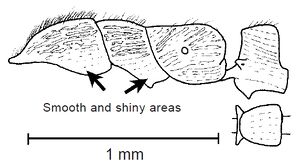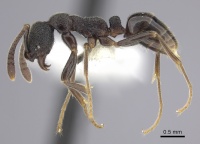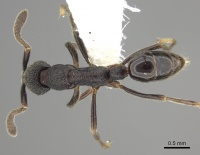Simopelta longinoda
| Simopelta longinoda | |
|---|---|

| |
| Scientific classification | |
| Kingdom: | Animalia |
| Phylum: | Arthropoda |
| Class: | Insecta |
| Order: | Hymenoptera |
| Family: | Formicidae |
| Subfamily: | Ponerinae |
| Tribe: | Ponerini |
| Genus: | Simopelta |
| Species: | S. longinoda |
| Binomial name | |
| Simopelta longinoda Mackay, W.P. & Mackay, E.E., 2008 | |
A relatively abundant species for the genus. It has been observed foraging in the canopy and on cool, rainy days at higher elevations.
Identification
Mackay and Mackay (2008) - The short antennal scape would cause confusion with Simopelta breviscapa, the other species in which the antennal scape barely exceeds the posterior lateral corner of the head. It can be easily separated by the narrower petiole node (length 0.23, maximum width 0.20 mm, versus length 0.23, width 0.25 mm in S. breviscapa) and in that the lower parts of the pronotum and mesopleuron are smooth and glossy (sculpture only moderately shiny in S. breviscapa). The predominantly punctured head could result in this species being misidentified as Simopelta oculata. It can be easily separated by the much smaller eye, and the shorter antennal scape (extends well past the posterior lateral corner in S. oculata).
Keys including this Species
Distribution
Latitudinal Distribution Pattern
Latitudinal Range: 10.23617° to 9.5534501°.
| North Temperate |
North Subtropical |
Tropical | South Subtropical |
South Temperate |
- Source: AntMaps
Distribution based on Regional Taxon Lists
Neotropical Region: Costa Rica (type locality).
Distribution based on AntMaps
Distribution based on AntWeb specimens
Check data from AntWeb
Countries Occupied
| Number of countries occupied by this species based on AntWiki Regional Taxon Lists. In general, fewer countries occupied indicates a narrower range, while more countries indicates a more widespread species. |

|
Estimated Abundance
| Relative abundance based on number of AntMaps records per species (this species within the purple bar). Fewer records (to the left) indicates a less abundant/encountered species while more records (to the right) indicates more abundant/encountered species. |

|
Biology
Longino reports the following from Costa Rica: I know this species from 15 separate collections, making it one of the more commonly encountered. It occurs above 800m in the Peñas Blancas Valley and Monteverde cloud forest. I have also seen collections from 700m at Pitilla Biological Station in the Cordillera de Guanacaste, from 1000-1500m elevation in Braulio Carrillo National Park, and at 1200m in Wilson Botanical Garden near San Vito. In Monteverde, I have observed columns foraging high on the Chomogo trail, on cold rainy days. I also observed a column of this species high in the canopy of a cloud forest tree.
JTL15Feb82/1300: Traveling in short columns across the surface of a moss mat. I initially disturbed them, then watched for about one hour. The columns seemed to move back and forth over roughly the same path, disappearing at both ends into the epiphytes. I saw only two ants carrying anything: small hairy larvae; both collected. Afterwards I dug through the epiphytes, but I could find no central nest or brood, just scattered workers. [I cannot locate the "small hairy larvae."]
JTL1991: Cloud forest on ridge crest, juncture of Nuboso and Brillante trails. Simopelta with Pheidole boruca prey; diffuse raiding party on and in moss/soil interface, on ground in treefall gap. Stray Pheidole boruca workers seen in area carrying brood.
Castes
Known only from the worker caste.
Worker

| |
| . | |
Nomenclature
The following information is derived from Barry Bolton's Online Catalogue of the Ants of the World.
- longinoda. Simopelta longinoda Mackay & Mackay, 2008: 307, figs. 17, 39 (w.) COSTA RICA.
- Type-material: holotype worker, 1 paratype worker.
- Type-locality: holotype Costa Rica, Prov. Guanacaste, Est. Pitilla, 700 m., 9 km. S Sta Cecilia, PN Guanacaste2-9.iii.1992, L-N 330200, 880200 (C. Moraga); paratype with same data.
- Type-depositories: INBC (holotype); WEMC (paratype).
- Distribution: Costa Rica.
Unless otherwise noted the text for the remainder of this section is reported from the publication that includes the original description.
Description
Worker
The worker is a small (2.2-2.5 mm), black ant with dark brown legs. The head length ranges from 0.70-0.71 mm, the head width ranges from 0.51-0.53 mm. The mandible has three teeth, the anterior border of the clypeus is convex, and slightly overhangs the clypeal apron. The eye is small (maximum diameter 0.05 mm), located about two diameters from the anterior margin of the head. The scape is short, extending only slightly past the posterior lateral corner of the head. The sides of the head are nearly straight and parallel, the posterior border is weakly convex. The dorsum of the mesosoma is nearly straight, the mesonotum is slightly shorter than the dorsal face of the propodeum. The anterior face of the petiole is concave, the posterior face is straight, the two faces are nearly parallel, and the dorsal face is broadly convex. The spiracular horns are moderately developed, and the subpetiolar process is weakly developed. The petiolar node is long and narrow as seen from above.
Erect hairs (up to 0.1 mm) are present on the clypeus, and a few are present on the dorsum of the mesosoma, and all surfaces of the gaster, the remainder of the hairs are short (0.03 mm), and present on the dorsum and ventral surfaces of the head, the scapes, sides of the head, posterior border, dorsum of the mesosoma, very sparse on the petiole, and gaster, the hairs on the legs are similar, and suberect.
The head is covered by large punctures, with the region between them being smooth and glossy, those on the anterior half of the head are more scattered, those on the posterior half are in rows, giving that region the appearance of having transverse striae, the dorsum of the mesosoma is similar, the punctures on the side of the mesosoma are mixed with striae, the lower third of the pronotum, lower fourth of the mesopleuron, and the gaster are smooth and glossy.
Type Material
Holotype worker (Instituto Nacional de Biodiversidad), one paratype worker (William and Emma Mackay Collection), Est. Pitilla, 700m, 9km S Sta. Cecilia, P.N. Guanacaste, Prov. Guanacaste, Costa Rica, C. Moraga, 2-9 mar 1992, L-N 330200,880200.
Etymology
From Latin, longus, meaning long and nodus, meaning swelling or node, referring to the relatively longer petiolar node as compared to the close relative S. breviscapa.
References
References based on Global Ant Biodiversity Informatics
- Longino J. T. L., and M. G. Branstetter. 2018. The truncated bell: an enigmatic but pervasive elevational diversity pattern in Middle American ants. Ecography 41: 1-12.
- Longino J. et al. ADMAC project. Accessed on March 24th 2017 at https://sites.google.com/site/admacsite/

